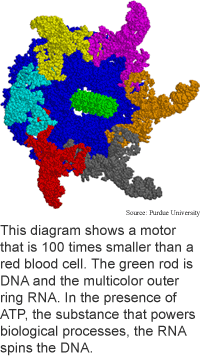
RNA forms nanomotor
Researchers from Purdue University have constructed
a tiny motor from DNA and RNA molecules. The device, fueled by ATP, which
powers our own movements, could eventually power nanomachines.
The motor measures about 30 nanometers long, which is less than
one hundredth the size of a red blood cell.
It is made from six strands of RNA surrounding a center strand of
DNA. In the presence of ATP, the RNA strands push the DNA axle in succession,
spinning it around. This produces 50 to 60 piconewtons, or trillionths of
a newton of force. A falling apple exerts about one newton of force.
The motor has potential in biological applications as well. The
researchers have driven the tiny motor axle through the protective protein
coat of a virus. The motor could eventually be used to deliver genes or
therapeutic molecules into live cells, according to the researchers.
The motor could be used in practical applications in two to five
years, according to the researchers. The work appeared in the February issue
of the Journal of Biological Chemistry. -TECHNOLOGY RESEARCH NEWSW
Quantum chips advance
Cheap solar power on deck
Paper speeds video access
Chip device gets to the point
News briefs:
Warping yields better light chip
Supersensitive disk drives on tap
Lasers tweeze every which way
RNA forms nanomotor
Cold logic promises speedy devices
Net has few degrees of separation

Research Watch blog
View from the High Ground Q&A
How It Works
RSS Feeds:
News
Ad links:
Buy an ad link
Ad links: Clear History
Buy an ad link
|
TRN
Newswire and Headline Feeds for Web sites
|
© Copyright Technology Research News, LLC 2000-2010. All rights reserved.